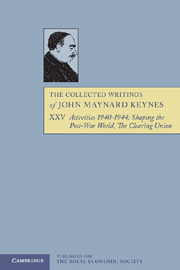Book contents
- Frontmatter
- Contents
- General introduction
- Editorial note
- 1 THE ORIGINS OF THE CLEARING UNION, 1940–1942
- 2 FROM CABINET AGREEMENT TO WHITE PAPER, 1942–1943
- 3 FROM WHITE PAPER TO JOINT STATEMENT, APRIL 1943 TO APRIL 1944
- Appendix 1 Changes from Draft of 4 August 1942 in Version sent to H. D. White on 28 August 1942
- Appendix 2 Changes from Draft sent to H. D. White on 28 August 1942 in the Version sent after the Dominions Discussions, 9 November 1942
- Appendix 3 Changes from the Draft of 9 November 1942 in the White Paper published on 7 April 1943 other than the Preface
- Appendix 4 Joint Statement by Experts on the Establishment of an International Monetary Fund
- List of Documents Reproduced
- Acknowledgements
- Index
3 - FROM WHITE PAPER TO JOINT STATEMENT, APRIL 1943 TO APRIL 1944
Published online by Cambridge University Press: 05 November 2012
- Frontmatter
- Contents
- General introduction
- Editorial note
- 1 THE ORIGINS OF THE CLEARING UNION, 1940–1942
- 2 FROM CABINET AGREEMENT TO WHITE PAPER, 1942–1943
- 3 FROM WHITE PAPER TO JOINT STATEMENT, APRIL 1943 TO APRIL 1944
- Appendix 1 Changes from Draft of 4 August 1942 in Version sent to H. D. White on 28 August 1942
- Appendix 2 Changes from Draft sent to H. D. White on 28 August 1942 in the Version sent after the Dominions Discussions, 9 November 1942
- Appendix 3 Changes from the Draft of 9 November 1942 in the White Paper published on 7 April 1943 other than the Preface
- Appendix 4 Joint Statement by Experts on the Establishment of an International Monetary Fund
- List of Documents Reproduced
- Acknowledgements
- Index
Summary
With the publication of the proposals for the Clearing Union and the Stabilisation Fund, and the prospect of further talks, discussion centred to a considerable extent on the meaning of the American proposals. Soon after publication, D. D. Braham, a leader writer on The Times wrote to Keynes, thanking him for a briefing and stating that he had found the American proposals ‘very difficult to disentangle’. ‘From one passage’, he continued, ‘it looks as if they actually proposed in certain cases to limit and ration American exports. Surely they can hardly mean this, for it would provoke a storm of protest by American manufacturers and even from American labour.’
Keynes replied
To D. D. BRAHAM, 12 April 1943
My dear Braham,
Thanks for your letter of April 9th, and particularly for your leader, which took just the right line, I thought.
In your letter you have, of course, touched the spot so far as the American proposals are concerned. The main question is whether that peculiar passage to which you refer is or is not to be believed and taken seriously. It is, of course, absolutely essential to the logic of the scheme. For under the American plan clearly a currency can become scarce, and some answer must be produced to the question what one then does about it. The answer actually given is the rationing proposal to which you call attention.
- Type
- Chapter
- Information
- The Collected Writings of John Maynard Keynes , pp. 238 - 448Publisher: Royal Economic SocietyPrint publication year: 1978



